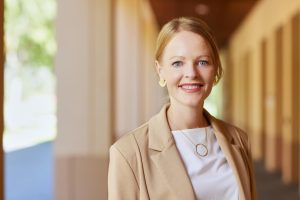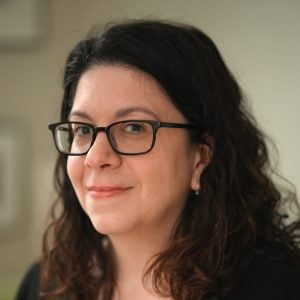In this installment of our Admissions Director Q&A series, we welcome Erin Nixon, the new Assistant Dean of Admissions and Financial Aid at Stanford GSB.
Before returning to the GSB for this role earlier this year, Erin worked as a strategy and operations executive across industries and geographies, including with BCG, LinkedIn, and early-stage startups and small businesses in the U.S. and Europe. Originally from Austin, Texas, Erin received her undergraduate degree in Economics from Stanford University and her MBA from Stanford GSB. Having spent the last 10 years living in London and Barcelona, she is delighted to be back home on the Farm.
Keep reading to get Erin’s favorite aspects of the MBA program at GSB and her insight into what you need to know about the application process.

Clear Admit: What is the one aspect of your program that you wish applicants knew more about?
Erin Nixon: I wish people knew more about the ways our academic experience is unique. The opportunities for learning are incredible, and the people who get the most from the program are those who lean all the way in. It’s a special thing to be on our beautiful campus, with access to inspiring courses and inspiring people who can fuel your growth.
For example, we have electives co-taught by faculty, who are the best experts in the world in what they do, alongside practitioners, who bring these concepts to life through their incredible leadership experiences in the business world and beyond. We also use a variety of teaching methods designed for each course to maximize different learning goals – sometimes the case method, sometimes experiential, sometimes group project based, and more. And our faculty are surprisingly accessible, investing in students’ learning and development both in and out of the classroom.
CA: Walk us through the life of an application in your office from an operational standpoint. What happens between the time an applicant clicks “submit” and the time the committee offers a final decision?
EN: We often get asked this question, so I’m happy to clarify our process. I hope none of it comes as too much of a surprise, as our intent is to keep it straightforward.
We first prepare the applications for review. Then we evaluate each application and decide which candidates will move forward to the next stage, the interview.
Next, we will email interview invitations. Please note that invitations go out over a period of weeks because we are carefully reading each application, and this takes us a meaningful amount of time. Interviews may be conducted virtually or in person.
Next we carefully read interview notes and make our final decisions. After months getting to know applicants through their applications, this is a pretty exciting time for us as we begin to picture each new class that is coming together.
CA: How does your team approach the essay portion of the application specifically? What are you looking for as you read an essay? Are there common mistakes that applicants should try to avoid? What is one key thing they should keep in mind as they sit down to write?
EN: We read each essay carefully in the context of the broader application. We are not looking for any one answer specifically – we are genuinely curious to learn about you as an individual.
Specifically for the “What Matters Most” essay question, we recommend taking the time to think about what is authentic to you. Some people find it helpful to talk with family, friends or close colleagues as thought partners before they sit down to write.
I know that many people wish our advice were more formulaic or cookie-cutter! But the truth is that when I’m reading your application, I’m 100% focused on understanding your story. I’m not comparing you to other people; I have no “right answer” in mind. I really do want to get to know YOU.
So it’s not about what you think Admissions wants to hear; instead, what is it that you really want to tell us about you? You don’t have to “pitch” yourself to us, and there is no one specific “GSB archetype” we’re looking for. If anything, the way to “stand out” is to sit with and embrace the things that make you who you really are.
CA: Could you tell us about your interview process? Approximately how many applicants do you interview? Who conducts the interview (students, admissions officers, alumni) and what is the nature of the interview (resume-based, application-based, behavioral)? Will your admissions interviews be in-person or virtual for the 2024-2025 admissions season?
EN: This year, we are excited to reintroduce in-person interviews in addition to virtual interviews. Our interviews are conducted by a small trained and dedicated subset of our alumni community or by a member of the MBA Admissions team. They are between 45 and 60 minutes long and are in English.
We conduct a structured behavioral interview to gain a deeper understanding of what you have done and how you have done it. We focus on your past actions, rather than on hypothetical situations, and invite you to discuss meaningful professional or community-based experiences you’ve had in the past few years.
CA: What is your testing policy? Do you offer exam waivers? Why or why not?
EN: All applicants must submit a valid GMAT or GRE score. We accept test scores for the official online GMAT and GRE exams, as well as test scores from in-person exams at official GMAT and GRE test centers. We have no preference for one test over the other.
Further, applicants whose college or university taught in a language other than English must take an English language proficiency test, unless they also completed a graduate program taught exclusively in English. Stanford GSB accepts the TOEFL (Test of English as a Foreign Language), the PTE (Pearson Test of English Academic), or the IELTS (International English Language Testing System).
We do not offer exam waivers at this time.
CA: In the application data form, many schools ask for information about work experience, activities, hobbies, and much more. What advice would you give to applicants as they approach this component of the application process?
EN: Throughout your entire application, we are looking for evidence for how you think, how you lead, and how you see the world. You can use these sections about your work experience, impact, and activities to help us understand more about you in this light.
CA: Tell us briefly about two popular courses at your institution.
EN: There are so many interesting courses to choose from. A couple of favorites include:
FINANCE 385: “Angel and VC Financing for Entrepreneurs and Investors” taught by Ilya Strebulaev. This covers all the stages of funding for early-stage high-growth companies, from seed funding to venture capital rounds to a successful exit. This is a popular case-based course using real examples of companies. Often, protagonists from the cases – as well as other industry leaders – come to listen in to the discussion and share more about their learnings.
GSBGEN 312: “I’m Just a Bill” is another fascinating class taught by Keith Hennessey. Students role-play members of the U.S. government, engaging in legislative debate, voting, and negotiation with the goal of enacting new laws. You learn about policy issues like climate change, economics, regulation, and foreign policy while practicing your skills in leadership and influencing others.
But it’s not just about the electives here at Stanford. Even in the core curriculum, there are engaging courses like Optimization, Simulation and Modeling (otherwise known as “OSM;” pronounced “awesome”). Through OSM, students build a conceptual and computational foundation for tackling business problems around AI, data science, and data-driven decision-making. Our alumni have reported using OSM concepts to determine cost estimates when working as product managers, VC/PE investors, and for their own ventures, as well as in their personal lives, such as pricing their old used cars for sale.
CA: Is there anything else you’d like to highlight about your MBA program or admissions process?
EN: We look individually at every applicant, and we also look holistically at the community we are creating with each class. There is no one single profile we look for at Stanford GSB, and every class includes people bringing important perspectives into the classroom from a wide variety of industries, work experiences, and personal and professional backgrounds.
We emphasize the word community, because everyone benefits from the viewpoints of their talented and highly motivated peers. Because of our small class size, meaningful connections are made in these two years – connections that last a lifetime.





